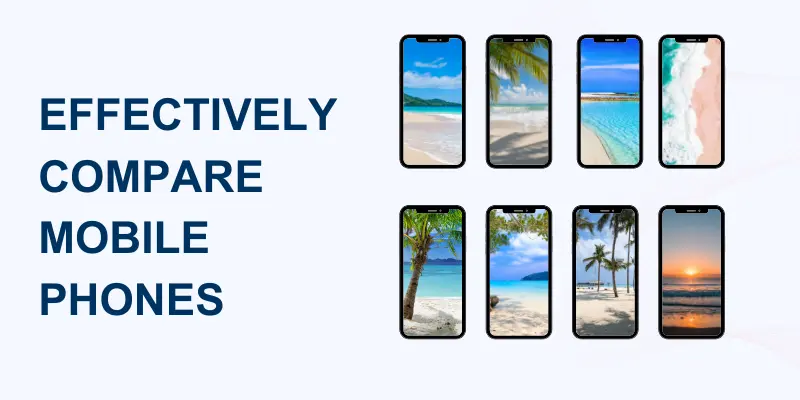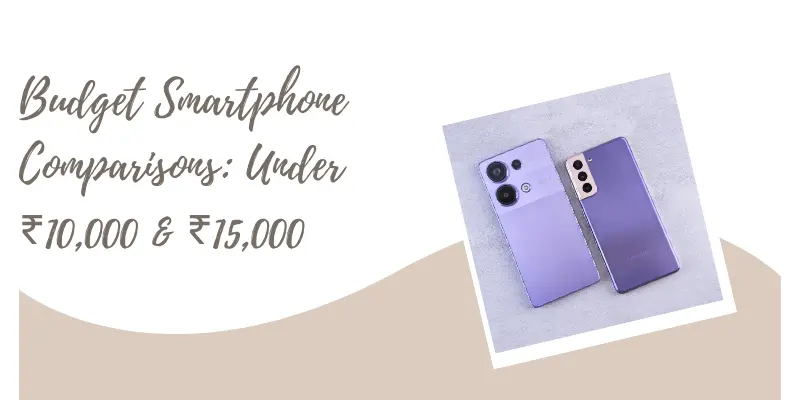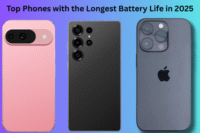Top Gadget Comparisons of 2025 – Save Money, Pick Smarter!
Published: 02 Jul 2025
Choosing the right gadget isn’t easy anymore. With dozens of brands and models, it’s easy to feel lost. That’s where comparisons help—fast. They show you what’s better, smarter, or more affordable. This guide will break it down for you—clearly and simply. Ready to find the perfect fit? Let’s dive in.
1. Introduction: Why Gadget Comparison Matters
In today’s fast-paced tech world, new gadgets hit the market every month. From smartphones to smartwatches, each device comes with its own set of features, prices, and promises. That’s why comparing gadgets has become more important than ever before.
When you compare gadgets, you’re not just checking specs—you’re making smarter decisions. You get to see which model offers better value, which one has longer battery life, or which has the best camera for your needs. Some phones may look similar but perform very differently in real-world use.
Comparing also helps you avoid overpaying. The same features can often be found at much lower prices across different brands. With the right comparison, you can save money while still getting exactly what you want.
Whether you’re upgrading your phone, buying a gift, or just curious about the latest tech—taking time to compare gadgets ensures you buy with confidence, not confusion.
2. How to Effectively Compare Mobile Phones

With so many smartphones on the market, comparing them can feel overwhelming. But breaking it down into key factors makes the process simple and effective. Here’s what to focus on when comparing mobile phones:
1. Specifications (Specs)
Start with the basics: processor, RAM, and storage. A powerful processor (like Snapdragon 8 Gen or Apple’s A-series) ensures fast performance. More RAM helps with multitasking, while adequate storage (at least 128GB) is essential for apps, photos, and videos.
2. Display Quality
Look at screen size, resolution (Full HD, AMOLED, etc.), and refresh rate (60Hz vs. 120Hz). A better display offers smoother visuals and a richer experience for gaming, streaming, and browsing.
3. Camera Performance
Don’t just count megapixels. Check for features like night mode, OIS (optical image stabilization), ultra-wide lenses, and 4K video recording. Read or watch reviews to see real-world camera results—because on paper isn’t always enough.
4. Battery Life & Charging Speed
Battery size matters (measured in mAh), but so does software optimization. A 5000mAh battery may last longer in one phone than another. Fast charging (like 33W, 65W, or more) can be a major plus for busy users.
5. Build Quality & Design
Consider materials (plastic vs. metal vs. glass), water resistance (IP ratings), and how the phone feels in hand. A sleek, durable phone that fits your style adds long-term satisfaction.
6. Brand Reputation & Software Updates
Established brands like Apple, Samsung, and Google often provide longer and more secure software support. Also consider user interface (iOS vs. Android vs. custom skins like One UI, MIUI, or OxygenOS).
7. Price & Value for Money
Always compare features against price. Mid-range phones now offer premium-like features—so higher cost doesn’t always mean better performance.
8. Network & Connectivity
Make sure the phone supports 5G if needed. Also check for dual SIM support, eSIM availability, Wi-Fi 6, Bluetooth version, and NFC (for contactless payments).
Tip: Use online comparison tools to place two or more phones side by side. Check real user reviews, benchmark scores, and expert opinions before making a final choice.
3. Top Mobile Phone Comparison Tools
Comparing mobile phones is easier than ever, thanks to powerful online tools. These platforms let you view specs, prices, features, and user reviews side by side—saving time and helping you make smart decisions. Here are the best tools to try:
1. GSMArena.com
One of the most trusted sites for phone comparisons.
Compare up to three phones side by side.
In-depth spec breakdown, battery tests, and real-world reviews.
Great for checking global and upcoming releases.
2. 91Mobiles.com
Perfect for Indian users looking for price-based comparisons.
Local pricing, offers, and user ratings.
Filters by budget, brand, features, and more.
Easy-to-use comparison tool for quick checks.
3. Smartprix.com
Another India-focused platform with detailed comparisons.
“Compare” button available on every phone listing.
Highlights pros and cons for each device.
Lists online deals and ratings across platforms like Flipkart and Amazon.
4. Versus.com
A global tool for comparing not just phones, but also laptops, headphones, and cameras.
Clean visual interface with side-by-side feature comparison.
Uses a scoring system to declare a winner.
Helpful for non-tech users who want clear answers fast.
5. PhoneArena.com
Ideal for in-depth comparisons with a U.S. focus.
Offers comparison charts, camera samples, and benchmarks.
Lets you check audio quality, display calibration, and more.
Useful for tech-savvy users.
6. Gadgets360 by NDTV
Great for comparing Indian market phones.
Real-time price comparisons from various retailers.
Expert reviews and user opinions.
Easily compare two or more phones with full details.
Bonus Tip:
Use YouTube channels like Geekyranjit, TechBurner, or MKBHD to see visual comparisons and camera tests. Real-world usage videos often show what specs can’t.
4. Latest Smartphone Comparison Highlights
With exciting new launches in 2025, smartphone comparisons are hotter than ever. Brands like Samsung, Apple, Xiaomi, and OnePlus are pushing boundaries, making side-by-side comparisons essential for buyers. Let’s explore some of the most talked-about matchups of the year so far:
1. Samsung Galaxy S25 Ultra vs. iPhone 16 Pro Max
Both flagships are powerhouses, but they serve different audiences.
- Galaxy S25 Ultra offers an advanced quad-camera setup, S-Pen, and more customization.
- iPhone 16 Pro Max focuses on software smoothness, cinematic video, and deep ecosystem integration.
Verdict: Choose Samsung for versatility; choose Apple for a seamless experience.
2. OnePlus 13 Pro vs. Xiaomi 15 Ultra
These two bring premium features at more competitive prices.
- OnePlus 13 Pro boasts lightning-fast charging, clean OxygenOS, and a stylish design.
- Xiaomi 15 Ultra delivers unmatched camera hardware, including a variable aperture lens.
Verdict: OnePlus is for performance lovers; Xiaomi is for camera enthusiasts.
3. Google Pixel 9A vs. Nothing Phone 3A
A battle of minimalism and smart performance in the mid-range market.
- Pixel 9A stands out for its stock Android, AI camera magic, and long software support.
- Nothing 3A brings a transparent design and clean UI with LED interface flair.
Verdict: Pixel 9A is smarter with software; Nothing 3A wins on looks and uniqueness.
4. Motorola Edge 50 Pro vs. Vivo V30 Pro
Popular in the upper mid-range segment.
- Motorola Edge 50 Pro offers near-stock Android with a high refresh rate OLED display.
- Vivo V30 Pro excels in portrait photography and stylish finish.
Verdict: Motorola for performance lovers; Vivo for mobile photography fans.
5. iQOO Neo 9 vs. Realme GT Neo 6
These brands aim at speed and gaming.
- iQOO Neo 9 comes with a flagship chipset, great thermals, and a bold design.
- Realme GT Neo 6 offers faster charging and aggressive pricing.
Verdict: Both are value beasts—pick iQOO for power, Realme for affordability.
These comparisons show how competitive the smartphone market has become. Each brand is targeting specific needs—whether it’s camera tech, gaming, or clean software. Always compare based on your usage style before choosing.
5. Most Popular Mobile Phone Comparisons
When it comes to smartphones, some comparisons never go out of style. These popular matchups dominate search trends and YouTube reviews because buyers want to see how top brands stack up against each other. Below are the most searched and discussed mobile phone comparisons of 2025:
1. iPhone 16 Pro Max vs. Samsung Galaxy S25 Ultra
The ultimate flagship face-off.
- iPhone 16 Pro Max offers unmatched video quality, long-term iOS support, and tight integration with Apple’s ecosystem.
- Galaxy S25 Ultra comes packed with a versatile camera setup, S-Pen support, and Android customization.
Why it’s popular: This is the battle of ecosystems—Apple’s simplicity vs. Samsung’s flexibility.
2. OnePlus 13 Pro vs. Xiaomi 15 Ultra
Two premium Androids at a competitive price.
- OnePlus 13 Pro is known for fast charging, refined OxygenOS, and sleek design.
- Xiaomi 15 Ultra delivers exceptional camera performance and strong hardware.
Why it’s trending: Users want premium features without the $1000+ price tag.
3. Pixel 9A vs. Nothing Phone 3A
Mid-range heroes with clean software.
- Pixel 9A offers a fantastic AI-powered camera and years of software updates.
- Nothing 3A turns heads with its transparent LED design and minimal interface.
Why it’s popular: Style meets smarts—both phones offer unique identities in the same price range.
4. Samsung Galaxy A55 vs. Redmi Note 13 Pro+
Strong performers in the budget-friendly premium segment.
- Galaxy A55 offers AMOLED display, reliable performance, and brand trust.
- Redmi Note 13 Pro+ shines with specs like 200MP camera, fast charging, and affordability.
Why it’s trending: Users love comparing reliable brand performance vs. spec-loaded budget devices.
5. iPhone 15 vs. iPhone 16
For Apple fans deciding whether to upgrade.
- iPhone 16 adds AI camera features, better battery, and a new chip.
- iPhone 15 still holds strong in performance and design.
Why it’s popular: Many users wonder if it’s worth upgrading or saving money.
These popular comparisons highlight what matters most to buyers—performance, value, design, and long-term reliability. Whether you’re a first-time buyer or planning an upgrade, knowing what others are comparing can guide you to a smarter choice.
6. Budget Smartphone Comparisons: Under ₹10,000 & ₹15,000

Looking for a smartphone that’s big on features but easy on your wallet? Budget smartphones in India are more powerful than ever, with great cameras, large batteries, and smooth displays—all under ₹15,000. Let’s compare the top picks in the under ₹10,000 and under ₹15,000 segments to help you choose the best value.
Top Phones Under ₹10,000
1. Redmi A3 vs. Poco C55
- Redmi A3: Stylish design, 6.7” display, 5000mAh battery.
- Poco C55: Strong MediaTek Helio G85 processor and decent camera setup.
Verdict: Choose Redmi A3 for design and display; Poco C55 for better performance.
2. Realme Narzo N53 vs. Infinix Smart 8
- Narzo N53: Sleek design, 33W fast charging, up to 6GB RAM.
- Infinix Smart 8: Large screen, AI camera, and Magic Ring feature.
Verdict: Narzo N53 is ideal for users wanting better battery and fast charging.
Top Phones Under ₹15,000
1. Redmi Note 13 4G vs. Realme Narzo 60x
- Redmi Note 13: AMOLED display, 108MP camera, Snapdragon 685.
- Narzo 60x: 5G support, 64MP camera, and stylish back panel.
Verdict: Redmi is best for content viewing; Narzo is perfect for 5G on a budget.
2. Motorola G73 5G vs. Samsung Galaxy M14
- Moto G73: Stock Android, MediaTek Dimensity 930, stereo speakers.
- Galaxy M14: 6000mAh battery, Exynos chip, solid Samsung brand trust.
Verdict: Motorola for clean software and balanced performance; Samsung for battery lovers.
3. iQOO Z6 Lite vs. Lava Blaze 5G
- iQOO Z6 Lite: Snapdragon 4 Gen 1, 120Hz display.
- Lava Blaze 5G: Indian brand, clean UI, and strong 5G performance.
Verdict: iQOO shines with better visuals; Lava is great for a clean and local experience.
Budget Buyer Tips:
- Prioritize battery and display for media use.
- Look for 5G support for future-proofing (especially in ₹15,000 range).
- Stick to brands with a good service network in your area.
Budget smartphones have come a long way—they now deliver features once found only in premium phones. With the right comparison, you can get a device that fits your needs without breaking the bank.
7. Best Camera Phones Compared
In 2025, smartphones aren’t just communication tools—they’re pocket-sized professional cameras. Whether you’re capturing sunsets, recording vlogs, or snapping Instagram-worthy shots, having a powerful camera phone matters. Let’s compare the top camera smartphones of the year and see which ones truly deliver.
1. Samsung Galaxy S25 Ultra vs. iPhone 16 Pro Max
- Galaxy S25 Ultra
200MP main sensor, periscope zoom lens, AI night mode.
Shoots 8K video with professional-grade stabilization.
Best for zoom, low-light photography, and detailed shots. - iPhone 16 Pro Max
48MP main sensor with sensor-shift stabilization, LiDAR.
Cinematic Mode, ProRes video, unbeatable color accuracy.
Best for video creators and natural-looking portraits.
Verdict:
Choose Samsung for zoom and advanced manual controls.
Go with iPhone for smoother video and natural color tones.
2. Xiaomi 15 Ultra vs. Vivo X100 Pro
- Xiaomi 15 Ultra
Variable aperture, Leica optics, 1-inch sensor.
Incredible flexibility in all lighting conditions. - Vivo X100 Pro
ZEISS optics, superb portrait and night photography.
Professional-style shots with minimal effort.
Verdict:
Xiaomi leads in raw detail and pro camera feel;
Vivo is the portrait and night mode king.
3. Google Pixel 9 Pro vs. Sony Xperia 1 VII
- Pixel 9 Pro
Tensor-powered AI enhancements, magic eraser, real-tone colors.
Effortless point-and-shoot excellence. - Xperia 1 VII
Manual controls, real-time eye tracking, pro videography tools.
Ideal for hobbyist photographers and content creators.
Verdict:
Pixel offers simplicity with stunning results.
Sony suits photography enthusiasts who want DSLR-like control.
4. Mid-Range Camera Champs: Nothing Phone 3A vs. iQOO Neo 9 Pro
- Nothing 3A
Dual sensors, Night Mode, clean software for faster shooting.
Great daylight shots and social media-ready filters. - iQOO Neo 9 Pro
Ultra-clear sensor, 4K video support, strong HDR.
Perfect for content on a budget.
Verdict:
Nothing Phone 3A is fun and stylish;
iQOO Neo 9 Pro packs more camera power for less money.
What to Look for in a Camera Phone:
- Main sensor quality: More than just megapixels.
- Stabilization: For steady photos and smooth videos.
- Low-light performance: Crucial for night shots.
- Software processing: AI can make or break your photos.
Whether you’re a casual snapper or a mobile photography pro, today’s top camera phones offer something for everyone. Compare wisely, and your next phone could be your best camera yet.
8. Brand-wise Comparison: Apple, Samsung, Xiaomi & More
When buying a smartphone, brand loyalty often plays a big role—but it’s smart to look beyond the logo. Each mobile brand has its strengths, price strategies, and audience. Let’s compare the most popular brands in 2025 and see how they stack up in terms of performance, price, and user experience.
Apple: Premium Ecosystem & Polished Experience
- Performance: Top-tier with A-series chips, seamless multitasking.
- Design: Sleek, durable, and consistent across generations.
- Camera: Excellent color accuracy and video capabilities.
- Price: High—starting at premium rates.
- User Base: Loyal users who prefer simplicity, privacy, and long-term support.
Best for: Creators, professionals, and ecosystem lovers.
Samsung: Innovation with Options for Every Budget
- Performance: Flagship S-series and foldables offer cutting-edge specs; A-series for budget buyers.
- Design: Stylish and functional, with curved displays and S-Pen integration.
- Camera: Powerful zoom, night photography, and versatility.
- Price: Wide range—from ₹10,000 to over ₹1 lakh.
- User Base: Tech enthusiasts, productivity users, Android fans.
Best for: Variety, high-end features, and display quality.
Xiaomi: Feature-Packed Phones at Disruptive Prices
- Performance: Great processors even in mid-range models.
- Design: Modern, bold looks; some inspired by flagships.
- Camera: Impressive hardware (108MP, Leica tuning in Ultra models).
- Price: Aggressively priced—ideal for budget and mid-range buyers.
- User Base: Value seekers, students, gamers.
Best for: Getting flagship-like features for less.
OnePlus: Speed, Clean UI & Performance Focus
- Performance: Flagship chips, great RAM management, fast charging.
- Design: Minimalistic, premium builds.
- Camera: Improving steadily, especially in Pro series.
- Price: Mid-range to premium.
- User Base: Performance lovers, multitaskers, clean UI fans.
Best for: Fast, reliable performance with near-stock Android feel.
Realme & iQOO: Power-Packed Budget & Mid-Range Kings
- Performance: High refresh rate displays, 5G support, gaming-ready chips.
- Camera: Decent at price, sometimes surprising in quality.
- Price: Very competitive—great for under ₹20K segments.
- User Base: Youth, gamers, budget buyers.
Best for: Performance on a tight budget.
Google Pixel: Pure Android & AI-Enhanced Photography
- Performance: Smooth software, optimized hardware.
- Camera: Legendary image processing, real-tone colors.
- Price: Mid to high.
- User Base: Android purists, photo enthusiasts, minimalists.
Best for: Camera clarity and software excellence.
Vivo & Oppo: Camera Innovation & Stylish Designs
- Performance: Balanced performance, camera-centric features.
- Design: Sleek, bold colors, curved displays.
- Camera: Strong portrait and low-light photography.
- Price: From affordable to premium.
- User Base: Style-conscious users, selfie lovers.
Best for: Mobile photography and sleek looks.
Quick Comparison Summary:
| Brand | Strengths | Ideal For |
| Apple | Ecosystem, privacy | Professionals, creators |
| Samsung | Variety, innovation | All-round users |
| Xiaomi | Value for money | Budget buyers |
| OnePlus | Speed, clean UI | Power users |
| Realme/iQOO | Performance on a budget | Gamers, students |
| Google Pixel | Camera, clean Android | Photography lovers |
| Vivo/Oppo | Design, camera features | Fashion-forward users |
Each brand brings something unique to the table. Choose based on what matters most to you—whether it’s speed, camera quality, style, or software experience.
9. Price Comparison: Finding the Best Deals
In a market flooded with smartphone options, the same phone can be sold at different prices on different platforms. If you want to get the best value for your money, smart price comparison is a must. Whether you’re shopping under ₹10,000 or going for a flagship, knowing where and when to buy can save you thousands.
Why Price Comparison Matters
- Prices can vary daily across platforms like Amazon, Flipkart, Croma, and official brand websites.
- Seasonal sales and bank offers make a huge difference.
- Bundled deals (with earphones, chargers, or exchange offers) can improve value.
Where to Compare Smartphone Prices in India
- Price Comparison Websites & Apps
- 91mobiles.com, Smartprix, Gadgets 360, and mysmartprice.com let you compare prices side-by-side.
- They also show price history, specs, and alerts for price drops.
- 91mobiles.com, Smartprix, Gadgets 360, and mysmartprice.com let you compare prices side-by-side.
- E-commerce Platforms
- Amazon India and Flipkart often run exclusive model launches and exchange deals.
- Look for “Deal of the Day” or “Lightning Deals” sections.
- Amazon India and Flipkart often run exclusive model launches and exchange deals.
- Official Brand Stores
- Brands like Realme, OnePlus, Xiaomi, and Samsung offer loyalty bonuses, cashback, and student discounts on their websites.
- Brands like Realme, OnePlus, Xiaomi, and Samsung offer loyalty bonuses, cashback, and student discounts on their websites.
Tips for Getting the Best Deals
Check prices on 2–3 platforms before buying.
Use bank offers (ICICI, HDFC, SBI) during sales for up to ₹5,000 off.
Look for exchange offers if you’re replacing an older phone.
Subscribe to alerts on comparison sites for price drops.
Buy during sales like Flipkart Big Billion Days, Amazon Great Indian Festival, or Diwali/New Year sales.
Avoid Common Mistakes
Don’t assume the lowest price always means the best deal—check warranty, return policy, and bundled offers.
Avoid unknown third-party sellers on platforms unless ratings are high.
Pro Tip:
Use Google Shopping to compare prices across e-commerce sites in real time. You’ll get product ratings, shipping costs, and seller details at a glance.
With a little effort, you can grab your dream phone at the best possible price. A smart buyer is a satisfied buyer—and price comparison is your secret weapon.
10. Final Thoughts: Choosing What’s Right for You
With countless smartphones on the market, the best gadget isn’t always the most expensive—it’s the one that fits your needs. After comparing specs, brands, cameras, and prices, the final decision depends on how you use your phone daily.
Focus on What Matters to You
- If you love photography, go for camera-centric phones like the iPhone 16 Pro Max or Xiaomi 15 Ultra.
- Need all-day power? Choose a device with a 6000mAh+ battery, like the Galaxy M14.
- Want smooth gaming? A phone with a high refresh rate and fast processor—like the iQOO Neo 9 Pro—will deliver.
- On a tight budget? Don’t worry—phones under ₹15,000 now offer amazing displays, good cameras, and 5G too!
Don’t Follow the Crowd
Just because a phone is popular doesn’t mean it’s right for you. A mid-range phone might suit your lifestyle better than a flagship. Always align your choice with:
- Your daily usage
- Your budget
- Your long-term expectations
Use Tools & Reviews to Your Advantage
Compare phones using trusted tools (91mobiles, Smartprix), check real user reviews on YouTube, and look for honest feedback on Reddit or tech forums. These will help you cut through marketing noise and make an informed, regret-free purchase.
Upgrade Smartly
Don’t chase every new release. If your current phone works well, wait for seasonal deals or meaningful upgrades like improved battery life, better cameras, or new network features.
Your ideal phone is out there—just a thoughtful comparison away.
CONCLUSION
In today’s fast-paced tech world, comparing gadgets—especially smartphones—has become essential. From cameras and performance to price and brand value, each factor plays a role in helping you choose the right device. With so many options available, using smart tools, reading comparisons, and knowing your own needs can make all the difference. Take your time, stay informed, and let your next smartphone be a perfect fit—not just for today, but for the years ahead.
FAQs
Use trusted tools like 91mobiles, Smartprix, and official brand websites to compare specs, prices, and user reviews.
Comparing helps you find better features at the right price and avoid overpaying for hype or outdated specs.
Popular options include 91mobiles, Smartprix, and Gadgets360.
Yes, most platforms let you compare megapixels, aperture, image stabilization, and real-world photo samples.
Check for a powerful processor (e.g., Snapdragon 8 Gen series), high refresh rate display, and thermal management.
Absolutely—many phones under ₹15,000 now offer excellent value with great cameras, displays, and 5G support.
Apple is great for ecosystem and stability; Samsung offers more variety across all price ranges.
Focus on sensor size, stabilization, low-light performance, and software optimization.
Compare across platforms, use bank offers, and buy during major sales like Diwali or Big Billion Days.
If your phone still works fine, wait 2–3 years unless a major feature upgrade matters to you.

- Be Respectful
- Stay Relevant
- Stay Positive
- True Feedback
- Encourage Discussion
- Avoid Spamming
- No Fake News
- Don't Copy-Paste
- No Personal Attacks

- Be Respectful
- Stay Relevant
- Stay Positive
- True Feedback
- Encourage Discussion
- Avoid Spamming
- No Fake News
- Don't Copy-Paste
- No Personal Attacks





